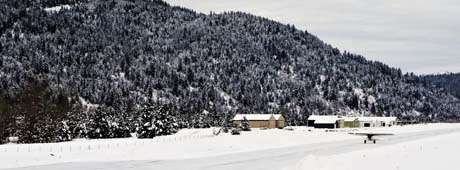No products in the cart.
Smelterville—Spotlight

Boom to Bust and Back Again
By Mary Terra-Berns
On a beautiful sky-blue but slightly blustery day last June, I flew at two thousand seven hundred feet from Coeur d’Alene to Missoula, Montana with my friend LaDonna Beaumont in her Cessna 172. From our elevated position, we identified various mountain peaks, alpine lakes, and other features below us as the plane followed Interstate 90 through the Silver Valley. Familiar places on the ground have a different perspective from above, and when we flew over Smelterville, I was astonished by the thousands of trees—healthy green trees. It isn’t unusual to see tree-covered hills in this part of the state but in Smelterville, that wasn’t the case a while back.
As I surveyed the verdant view, I recalled a drive past the town on Interstate 90 several years earlier, when I was amazed by the absence of vegetation—the predominant color around me was brown. The hills were devoid of anything green—not a tree, blade of grass, or lone shrub anywhere. Back then, Bunker Hill Mine and the tall, guilty looking smokestacks on the hillside gave obvious clues to the decline of both flora and fauna.
When silver was discovered in the Coeur d’Alene River Valley in 1885, it didn’t take long for the mining juggernaut to occupy the area, develop sites, and create the Coeur d’Alene Mining District in what became known as the Silver Valley. Mine mills materialized almost immediately and began processing tons of excavated ore into small pieces and powder to be bagged and shipped to smelters around the region. Using intense heat and chemicals, smelters separated gold, silver, lead, and other valuable metals from waste rock.
Transporting the ore was expensive, which severely impacted profits. In 1917, after many years of wrangling, Bunker Hill and Sullivan Mining and Concentrating Company built a smelter complex that consisted of about two hundred buildings, including three blast furnaces, four roasters, a baghouse (to remove some of the particulates from the air), a sinter plant (to agglomerate fine particulars that can be used for conversion of iron into steel), a lead smelter, and a silver refinery. The smelter complex was built on the grounds of the old Bingham and Giovetti Ranches, purchased in the summer of 1914, on the east side of contemporary Smelterville, above the Bradley Railroad Siding at the mouth of Government Gulch. An electrolytic zinc plant was added and began operation in 1928. By 1936, after expanding the facility, the Bunker Hill Smelter was the largest lead-producing facility in the world. A cadmium plant, to recover high-grade cadmium from smelter byproducts, was added in 1945.
This content is available for purchase. Please select from available options.
Register & Purchase Purchase Only
Register & Purchase Purchase Only


Comments are closed.